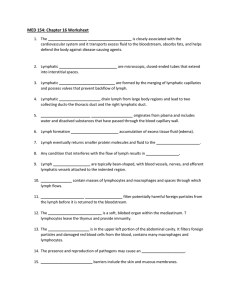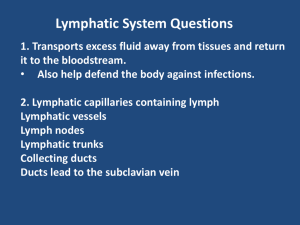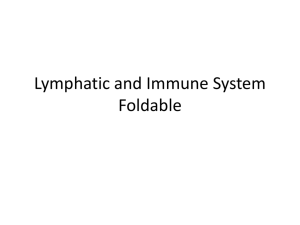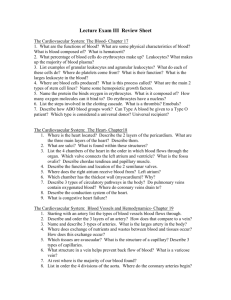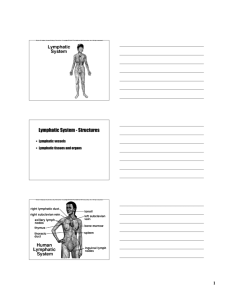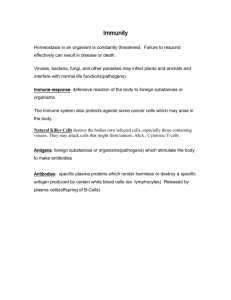Immune System - Cobb Learning
advertisement
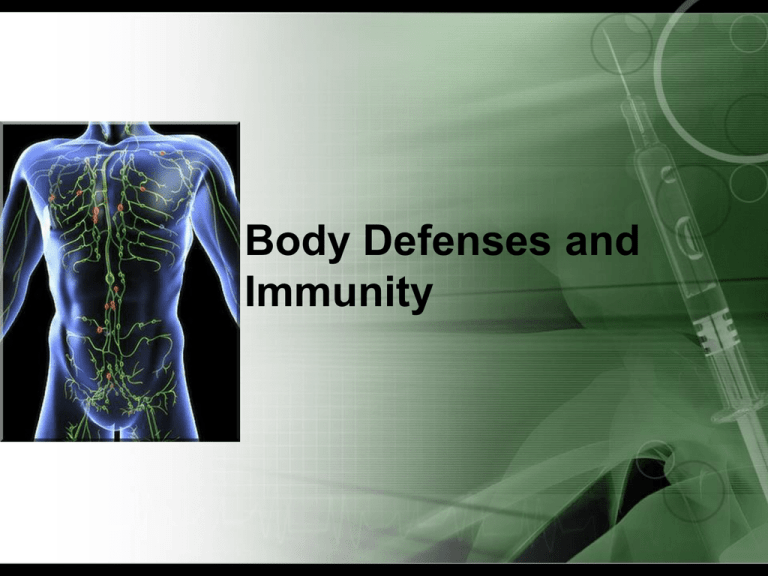
Body Defenses and Immunity The Lymphatic System Consists of two semiindependent parts Lymphatic vessels Lymphoid tissues and organs Lymphatic system functions Transports escaped fluids back to the blood Plays essential roles in body defence and resistance to disease Lymphatic Characteristics Lymph - excess tissue fluid carried by lymphatic vessels Properties of lymphatic vessels One way system toward the heart No pump Lymph moves toward the heart Lymph Harmful materials that enter lymph vessels Bacteria Viruses Cancer cells Cell debris Lymph Nodes Filter lymph before it is returned to the blood Defense cells within lymph nodes Macrophages—engulf and destroy foreign substances Lymphocytes—provide immune response to antigens Lymphatic Vessels Lymph capillaries Walls overlap to form flap-like mini-valves Fluid leaks into lymph capillaries Capillaries are anchored to connective tissue by filaments Higher pressure on the inside closes mini-valves Fluid is forced along the vessel Types of Defenses Innate (nonspecific defenses) Function the same way regardless of the pathogen type Adaptive (specific) defenses Immunity: targets certain pathogens Based on body’s ability to distinguish “self” from “non-self” Antigen – molecule that elicits an immune response Nonspecific Defenses Species resistance Mechanical barriers Chemical barriers Fever Inflammation Phagocytosis Inflammation Redness from blood vessel dilation Swelling from increased permeability of capillaries Heat from increased blood flow Pain Phagocytosis “Cell eating” Performed by neutrophils and macrophages that form from monocytes Development of Cells of Immunity Fetal bone marrow forms lymphocytes Lymphocytes differentiate: In thymus T cells In marrow B cells T cells can form B cells T and B cells circulate in bloodstream and are concentrated in lymph nodes and spleen T Cell Types Helper T cells Stimulate B cells to produce antibodies specific to an antigen Memory T cells Produced upon initial exposure to antigen but do not act until future exposure to the same antigen Cytotoxic T cells Destroy cancerous or virally-infected cells using perforin Once activated, proliferate to increase clones Primary vs. Secondary Immune Responses Primary Immune Response Occurs with first exposure to an antigen Production and release of antibodies continues for several weeks After primary response, memory T and B cells are produced Secondary Immune Response Occurs with future exposures to antigen Faster response time Primary Immune Response • Macrophages engulf invaders and present them to helper T cells in the nearest lymph node. Cell-Mediated Immunity • T cells attach to foreign cells and: a. Secrete toxins that kill target cells. b. Secrete growthinhibiting factors that prevent target cell growth. c. Secrete interferon that inhibits proliferation of viruses and tumor cells. Antibody-Mediated Immunity • • • Helper T cells activate B cells. B cells produce clones (plasma cells and memory B cells) and antibodies. Antibodies destroy antigen. Adaptive Immune Responses 2:51 Antibody Actions Directly attach to antigen and destroy it Label the antigen for destruction by macrophages Stimulate localized changes that help prevent the spread of antigens Secondary Immune Response Same process as primary immune response with some exceptions: Faster response time Memory B cells produce clones quickly Allergic Reactions An immune attack against a non-harmful substance May be caused by inherited tendency to overproduce IgE antibodies in response to certain antigens IgE triggers the release of histamine allergy symptoms If reaction is severe anaphylactic shock Types of Immunity Naturally acquired active immunity Develops after a primary immune response Artificially acquired active immunity Vaccine stimulates a primary immune response without causing symptoms Artificially acquired passive immunity Injection of antibodies; susceptibility may persist Naturally acquired passive immunity Antibodies passed to fetus from mother; persists 6 months to one year after birth 2:56 Autoimmunity When the immune system attacks “self” Examples of autoimmune diseases Multiple sclerosis - white matter of brain and spinal cord are destroyed Type I diabetes mellitus destroys pancreatic beta cells that produce insulin Rheumatoid arthritis - destroys joints


